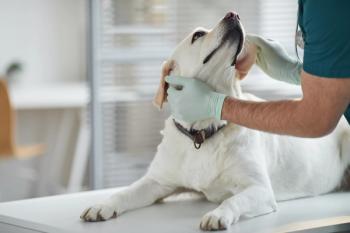
Canine Cushing's Case Files: The ins and outs of detection and treatment-Case file: Holly (Sponsored by Dechra Veterinary Products)
The use of properly dosed VETORYL Capsules is strongly recommended rather than compounded trilostane to ensure maximal efficacy and safety during medical management of hyperadrenocorticism.
Case file: HOLLY
8-year-old spayed female German shepherd weighing 33.3 kg (73.3 lb)
Patient history and initial referral findings
Holly's primary care veterinarian had diagnosed hyperadrenocorticism based on her history and clinical signs and the results of routine laboratory tests and a low-dose dexamethasone suppression test. Holly was treated for hyperadrenocorticism with trilostane (75 mg given orally once a day) obtained from a compounding pharmacy.
Dr. Christopher G. Byers
Six months later, Holly developed lethargy, vomiting, and abdominal distention and had markedly increased hepatic enzyme activities. The trilostane was discontinued and Holly was referred to MidWest Veterinary Specialty Hospital for an abdominal ultrasonographic examination. Peritoneal effusion secondary to a ruptured gallbladder mucocele was identified, and Holly was successfully managed with cholecystectomy and appropriate supportive critical care.
Follow-up referral evaluation
About one month after recovery from the cholecystectomy, Holly was again presented to MidWest Veterinary Specialty Hospital for evaluation of hair loss, increased panting, and polyuria and polydipsia. Holly's owners stated that she was otherwise clinically normal at home. Abnormalities identified on physical examination were patchy dorsolateral truncal alopecia with cutaneous hyperpigmentation, a pendulous abdomen, and moderate dental tartar with gingival inflammation (Figure 1).
Figure 1. When presented, 8-year-old Holly was experiencing increased panting, polyuria, and polydipsia. She had patchy dorsolateral truncal alopecia and a pendulous abdomen.
The results of a serum chemistry profile revealed increased alkaline phosphatase, alanine aminotransferase, asparagine aminotransferase, gamma-glutamyl transferase, and creatine kinase activities; hyperbilirubinemia; and hypercholesterolemia. The complete blood count results identified leukocytosis with a mature neutrophilia and monocytosis. Urinalysis showed a urine specific gravity of 1.027, bilirubinuria (1+; reference range = negative) and trace proteinuria (< 100 mg/dl; reference range = negative). All of these findings were deemed consistent with hyperadrenocorticism.
Confirmatory test results
The results of an adrenocorticotropic hormone (ACTH) stimulation test revealed a baseline cortisol concentration of 12.4 µg/dl (reference range = 2 to 6 µg/dl) and a one-hour post-ACTH cortisol concentration of 28.7 µg/dl (reference range =8 to 18 µg/dl). The abnormal ACTH stimulation test results in combination with Holly's history, clinical signs, and other abnormal laboratory test results confirmed hyperadrenocorticism.
The previous abdominal ultrasonographic examination and direct adrenal visualization at the time of exploratory laparotomy for cholecystectomy identified that both adrenal glands were normal size and shape, which is consistent with pituitary-dependent hyperadrenocorticism. Medical therapy options were discussed with the family, who elected treatment with VETORYL® Capsules (trilostane).
Treatment and follow-up
Treatment with VETORYL Capsules was begun at a dose of 3.6 mg/kg given orally once daily in the morning with food. The family was advised to keep a daily journal to document Holly's frequency of panting, water consumption, urination frequency, appetite voracity, and activity level. They were also asked to document any episodes of vomiting or diarrhea and to call with any questions or concerns. Holly's family was also advised to consult with her primary care veterinarian regarding prophylactic dental care.
Initial follow-up visits
At the two-week recheck visit, Holly's family reported reductions in her panting frequency, polydipsia, and polyuria. Her appetite was normal, and she had no episodes of vomiting or diarrhea. Holly's activity level was unchanged and still normal. A post-ACTH stimulation cortisol concentration measured 4.5 hours after administration of her VETORYL Capsules dose was 1.5 µg/dl, indicating adequate inhibition of glucocorticoid production. Based on these results and the improvement in her clinical signs, the initial VETORYL Capsules dosage was continued, and Holly was scheduled for a 30-day post-treatment recheck examination.
At the subsequent visit, the family reported Holly was doing exceptionally well at home with resolution of her excessive panting, polyuria, and polydipsia. Furthermore, her hair coat was markedly improved in fullness and luster, hyperpigmentation was not evident, and her abdomen was not pendulous. A serum chemistry profile revealed that her liver enzyme activities were improved, with only an elevated gamma-glutamyl transferase activity (previously 185 U/L; this visit = 15 U/L; reference range = 0 to 14 U/L). No abnormalities were identified on a complete blood count or urinalysis. A post-ACTH stimulation cortisol concentration measured four hours after the VETORYL Capsule dose was 1.7 µg/dl, indicating adequate inhibition of glucocorticoid production. The initial VETORYL Capsules dosage was continued, and a 90-day post-treatment recheck examination was scheduled.
Holly's long-term response
At her three-, six-, and nine-month posttreatment recheck visits, Holly continued to be clinically normal (Figure 2). The ACTH stimulation tests revealed post-ACTH cortisol concentrations of 3.1 µg/dl at three months, 2.3 µg/dl at six months and 2.3 µg/dl at nine months of VETORYL Capsules treatment. Holly was treated successfully by her primary care veterinarian for a presumptive bacterial urinary tract infection seven months after starting therapy. No adjustments were made in the VETORYL Capsules treatment protocol.
Figure 2. At her three-, six-, and nine-month post-treatment recheck appointments, Holly was clinically normal.
Dr. Byers' perspective
The use of VETORYL Capsules for the management of pituitary-dependent hyperadrenocorticism readily inhibits glucocorticoid production to promote resolution of common clinical signs caused by hyperadrenocorticism — most notably polyuria, polydipsia, increased panting, and hair coat changes — and biochemical derangements associated with this disease. The use of properly dosed VETORYL Capsules is strongly recommended rather than compounded trilostane to ensure maximal efficacy and safety during medical management of hyperadrenocorticism.1
When using VETORYL Capsules, encourage families to keep a detailed journal of their dog's daily activities, appetite, and thirst. In addition, advise owners to immediately report any possible adverse events, such as hyporexia or anorexia, vomiting, and diarrhea. Information about a patient's clinical condition is essential when interpreting post-ACTH stimulation cortisol concentrations and making recommendations for VETORYL Capsules dosage adjustments.
Dr. Byers is the faculty criticalist/ internist at MidWest Veterinary Specialty Hospital in Omaha, Neb., and is an adjunct associate professor in the Department of Clinical Sciences at Kansas State University's College of Veterinary Medicine.
REFERENCE
1. Cook AK, Nieuwoudt CD, Longhofer SL. Pharmaceutical evaluation of compounded trilostane products. J Am Anim Hosp Assoc 2012;48:228-233.
This case was solicited from the prescribing veterinarian and may represent an atypical case study. Similar results may not be obtained in every case.
Hyperadrenocorticism affects many adult dogs. Whether the disease is pituitarydependent (80% to 85% of spontaneous cases) or adrenal-dependent (15% to 20% of cases), the clinical and laboratory abnormalities associated with it result from chronic hypercortisolemia. Clinical signs of hyperadrenocorticism at the time of diagnosis can vary widely, and they develop so gradually that owners often mistake the signs for "normal" aging. Being aware of the more subtle signs of canine hyperadrenocorticism can be key to early diagnosis and initiation of therapy.
Common clinical signs of canine hyperadrenocorticism
Whenever possible, pituitary-dependent hyperadrenocorticism and adrenal tumors should be differentiated to help guide therapy and patient monitoring. Early diagnosis and management of canine hyperadrenocorticism may not only improve the patient's clinical signs but may also keep the more severe consequences of Cushing's syndrome from developing.
Learn more with these online resources
Go to the Dechra Veterinary Products CE Learning Center at
• Diagnosing and treating canine hyperadrenocorticism
Presented by Audrey K. Cook, BVM&S, MRCVS, DACVIM, DECVIM, and David s. Bruyette, DVM, DACVIM
• Cushing's disease: Inside and out
Rhonda Schulman DVM, DACVIM, and John Angus, DVM, DACVD
• Diagnosing and treating feline hyperthyroidism
Presented by Andrew J. Rosenfeld, DVM, DABVP
Then get your whole team on the same page, by visiting the Team Meeting in A Box section at
• Stop getting burned by ear infections
How you handle otitis externa and ear infections can make or break client bonds—and dogs' well-being. Use this Team meeting in a Box to create a team approach to help pet owners and heal patients.
• Coping with Cushing's syndrome
Pets with Cushing's syndrome suffer from a chronic illness that will be managed throughout the pet's life, not cured. This Team Meeting in A Box will help you deliver a successful team-wide approach.
Visit
Newsletter
From exam room tips to practice management insights, get trusted veterinary news delivered straight to your inbox—subscribe to dvm360.






